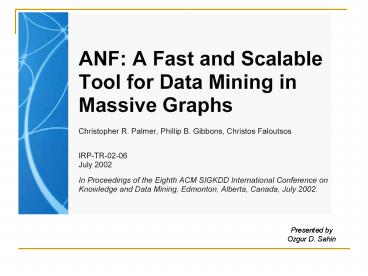Presented by Ozgur D. Sahin - PowerPoint PPT Presentation
1 / 23
Title:
Presented by Ozgur D. Sahin
Description:
Presented by Ozgur D. Sahin – PowerPoint PPT presentation
Number of Views:41
Avg rating:3.0/5.0
Title: Presented by Ozgur D. Sahin
1
Presented by Ozgur D. Sahin
2
Outline
- Introduction
- Neighborhood Functions
- ANF Algorithm
- Modifications
- Experimental Results
- Data Mining using ANF
- Conclusions
3
Introduction Motivation
- Graph-based data is becoming more importatnt
- Internet modeling, academic citations, phone
records, movie databases, CAD circuits - Example Questions
- How robust is the Internet to failures?
- What are the most influential database papers?
- What is the best opening move in tic-tac-toe?
- Are phone call patterns in Asia similar to those
in the U.S.? - Goal Quickly answer questions on graph-
represented data
4
Answering Questions
- We can answer these questions if we can compute
following three properties related to
connectivity and neighborhood structure - Graph Similarity Decide if two graphs have
similar connectivity/neighborhood structure - Subgraph Similarity Compare how two subgraphs of
a given graph are connected - Vertex Importance Assign an importance to each
node based on its connectivity - This paper provides such a tool ANF (Approximate
Neighborhood Function)
5
Challenges
- Following properties should be satisfied
- Error Guarantees Accurate estimates
- Fast Scale linearly with n ( of nodes) and m (
of edges) - Low Storage
- Adapts to available memory
- Parallelizable
- Sequential scan of the edge file
- Estimates per node
6
Definitions - Neighborhood Functions
dist(u,v) of edges on the shortest path from u
to v Define following neighborhood functions
7
Definitions - Neighborhood Functions
Generalize these two definitions to deal with
subgraphs
8
Basic ANF Algorithm
- N(h) can be computed by a graph traversal
- Graph traversal accesses edges in random order
- Running time is O(nm)
- Access edges in sequential order
- M(x,h) is the set of nodes within distance h of
node x
9
Basic ANF Algorithm
- How to compute the number of distinct elements in
the set M(x,h) - A dictionary data structure O(n2log n)
time/space - Use bits to mark membership O(n2) space
- Use probabilistic counting algorithm
- Approximate set sizes using log nr bits
10
Probabilistic counting algorithm
- Approximate set sizes using log nr bits
- Instead of one bit per node, give half the nodes
bit 0, a quarter of them bit 1, and so on (A node
is given bit i with probability 1/2i1) - The approximation of the size of a set is
proportional to 2b, where b is the least bit that
has not been set in the bit representation of
this set - Use k parallel approximations
- M(x,h) is represented by k(log nr) bits
11
Basic ANF Algorithm
- Consider a ring with 5 nodes
- Example for k3 and r0
- Bit 0 is the leftmost bit in each 3-bit mask
- M(2,1) is the union of M(2,0), M(1,0), and
M(3,0) - M(2,1)M(2,0) OR M(1,0) OR M(3,0)
- IN(2,1) is computed from the average of the least
zero bit positions - Avg(211)/34/3 ? IN(2,1) (24/3)/0.77359
3.25
12
Basic ANF Algorithm
13
Modifications
- M(x,h) uses M(y,h-1) but not M(y,h-2), so just
keep the M(y,h-1) during iteration h. - Include a mark bit to handle generalized
neighborhood functions - Break bit masks into smaller pieces if they are
larger than the available memory
14
Leading Ones Compression
- As ANF runs, most bit masks will have many
leading 1s - Compress bit masks by including a counter of the
leading ones - Bit shuffling of k parallel bit masks enables
further compression - 11010,11100 ? 1111011000
- Provides up to 23 speed-up
15
Experiments
- Data Sets 3 real (Router, Cornell, Cora) and 4
synthetic - Evaluation Metric
16
Experiments - Accuracy
k64 - ANF achieves less than 7 error - ANFs
error is independent of the data set
17
Experiments - Time
18
Experiments - Scalability
19
Data Mining with ANF
- ANF tool can be used to answer graph mining
problems - Best opening move for Tic-Tac-Toe game
- Clustering movie classes
- Measuring the robustness of the Internet
- Use summarized statistics derived from
neighborhood function - Many real graphs follow a power law
- N(h) µ hH, where H is defined as the hop
exponent - Use individual hop exponent as a measure of
importance
20
Tic-Tac-Toe
- Show The best opening move is the center square
- Each possible board configuration is a node and
there is an edge from board x to board y if it is
a possible move - Compute individual neighborhood functions for
each of the 9 possible first moves
21
Clustering Movies
- Consider IMDB (Internet Movie Data Base) where
each movie is identified as being in one or more
classes (such as documentaries, dramas, comedies,
etc) - Construct a graph for each class and cluster
similar ones
22
Internet Router Data
- How robust the Internet is to router failures
- Delete some number of routers and measure
connectivity
- Random failures do not disrupt the Internet
- Targeted failures can dramatically disrupt it
23
Conclusions
- ANF uses an efficient and accurate approximation
algorithm - ANF tool provides several advantages including
following - Accurate
- Fast
- Low storage requirements
- Parallelizable
- ANF makes it possible to answer many interesting
questions































